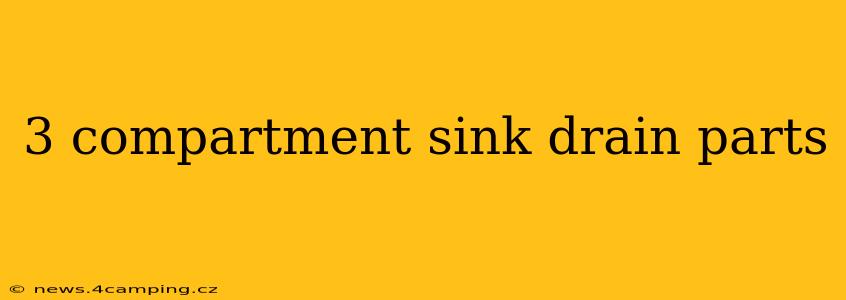Understanding the Anatomy of a 3-Compartment Sink Drain: Parts and Troubleshooting
Three-compartment sinks, often found in commercial kitchens or industrial settings, require a more complex drain system than standard single-basin sinks. Understanding the various parts and how they function is crucial for both installation and troubleshooting. This guide will delve into the components of a 3-compartment sink drain, addressing common questions and providing valuable insights for maintenance.
What are the main parts of a 3-compartment sink drain?
The drain system for a three-compartment sink typically includes several key components working in concert:
-
Individual Sink Strainers: Each compartment has its own strainer, usually a basket-style strainer designed to catch larger food particles and debris, preventing clogs further down the line.
-
Tailpieces: These connect the sink strainers to the main drain lines. They're usually P-traps (or variations) to maintain a water seal preventing sewer gases from entering the kitchen.
-
Interconnecting Pipes: These pipes connect the tailpieces from each sink compartment, often merging into a single larger diameter pipe.
-
Main Drain Line: This is the larger pipe that carries wastewater from all three compartments to the building's main drain system.
-
Cleanout: A crucial component for maintenance, the cleanout allows access to clear clogs from the main drain line. This is typically a capped section of pipe easily accessible for cleaning.
-
Air Gap (Sometimes): In certain installations, especially commercial settings, an air gap is employed. This prevents wastewater from backflowing into the sink compartments.
-
Waste Disposal (Optional): Some 3-compartment sink systems integrate garbage disposals, usually in one or more compartments. This requires additional plumbing components and connections.
How does a 3-compartment sink drain work?
Wastewater from each compartment flows through its respective strainer and tailpiece. The interconnected pipes merge the wastewater streams from the three compartments into a single flow for the main drain line. The P-traps (or similar) maintain the water seal, preventing sewer odors from escaping. The cleanout provides easy access for clearing any clogs or blockages that may occur in the main drain line.
What are the common problems with 3-compartment sink drains?
Common issues include:
-
Clogs: Frequent clogs are the most common problem, typically caused by accumulated food scraps or grease build-up in the strainers, tailpieces, or main drain lines.
-
Leaks: Leaks can occur at pipe joints or due to damaged tailpieces or strainers.
-
Sewer Gas Odors: This usually indicates a problem with the P-traps, possibly due to insufficient water seal, or a blockage further down the drain line.
-
Slow Drainage: This points to a partial blockage somewhere in the drain system.
How do I fix a clogged 3-compartment sink drain?
First, attempt to clear clogs using a drain snake or plumber's auger. If the clog persists, you may need to access the cleanout to clear the blockage from the main drain line. Severe clogs may require professional plumbing assistance. Regular maintenance, such as periodic flushing with hot water and cleaning the strainers, helps prevent clogs.
What are the different types of 3-compartment sink drains?
The specific design and components of a 3-compartment sink drain can vary depending on the manufacturer and the sink's overall design. Some may use different types of tailpieces, different methods of connecting the compartments, or incorporate features like waste disposals. Refer to the installation manual for specifics on your system.
How often should I clean my 3-compartment sink drain?
Regular cleaning is vital to prevent clogs and maintain proper drainage. Cleaning the strainers regularly and flushing the drain lines with hot water (possibly with a drain cleaner) should be done at least weekly, or more frequently depending on usage. Regular maintenance will significantly extend the lifespan of your drain system and prevent costly repairs.
This comprehensive guide provides a solid foundation for understanding and maintaining a 3-compartment sink drain. While this information is intended to be helpful, remember that complex plumbing issues often warrant the expertise of a qualified plumber.
